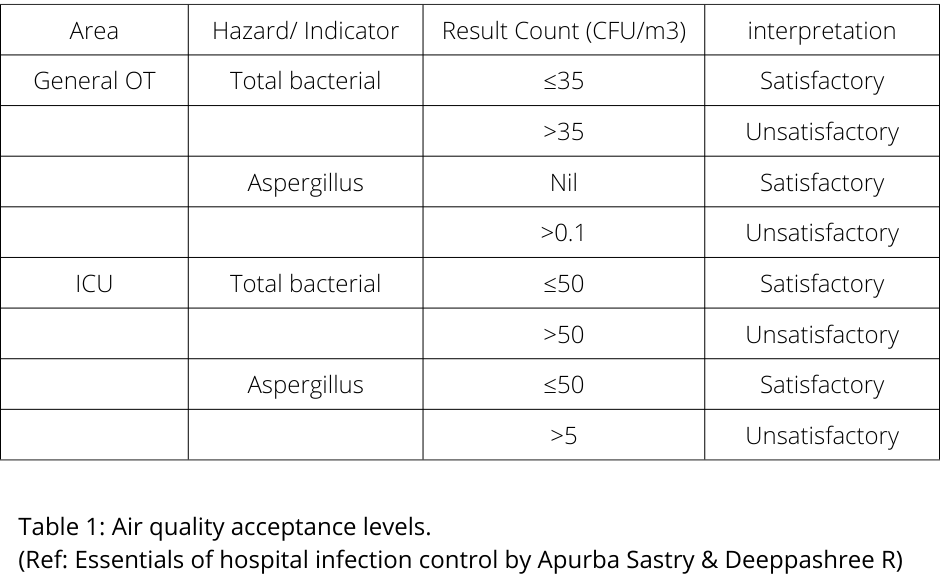April 11, 2022 admin
Microbial Air Monitoring
Air is a major reservoir for microorganisms:
Hospital environments are majorly contaminated by aerosols generated due to sneezing, coughing, poor maintenance of indoor air quality, and inadequate hygiene precautions. This leads to microbiological contamination of the hospital environment, which is the main cause of nosocomial infections. As a precautionary measure, CDC and WHO recommends a disinfection and air monitoring protocol for hospitals. The Indoor Air Quality (IAQ) of a hospital is to be examined to avoid the threat of nosocomial infections. The poor IAQ increases the prevalence of hospital-associated infection and foists an economic burden on the hospital. Air monitoring is as important in manufacturing facilities and cleanrooms, like hospitals. The food, pharmaceutical, and dairy products manufacturing units need to maintain the microbial components in the air to prevent cross-contamination of finished products.
Environment Disinfection to get rid of Air Microflora:
Environmental disinfection is a fundamental principle for infection control in healthcare settings and contamination control in cleanrooms of manufacturing facilities. The complete disinfection of the hospital environment includes instrument disinfection, surface, and environment disinfection. The procedure for environmental disinfection is done by fogging. In fogging, aerosols of disinfectants are created by pressurizing the disinfectant solution through a fogger machine. These saturated aerosols get integrated with the microbial particles in the air and disinfect the environment. Disinfectant fogging ensures the killing of potential pathogens. A wide range of chemicals is approved for disinfection of hospital facilities and clean rooms. These chemicals need to be approved by the Environmental Protection Agency (EPA) to mark their safety. The WHO and CDC guidelines mention the safety levels of chemicals used for critical and non-critical areas. The most recommended chemicals are the Quaternary Ammonium Compounds, tertiary amines and some aldehydes for instrument disinfection.
Surveillance of Airborne pathogens for infection control:
The microbial load in the air is measured by counting the colony-forming units per cubic meter (cfu/m3). The samples of air are collected by the active or passive sampling method. Active air sampling is a procedure, where the air is kinetically withdrawn with a sampler on a nutrient agar plate. The commercial active air samplers are of the following types; impingers, impactors of slit or sieve type, filtration samplers, electrostatic precipitation samplers, thermal precipitation samplers, etc.
The active air samplers must be sterilized and continuously calibrated to achieve expected results. The air is been sucked and settled on the plate. The suction pressure creates artificial turbulence which gives disparity in results depending on the type of sampler used. There is no fixed protocol for the choice of the sampler. The passive air sampling consists of a simple settle plate method. The environmental air from the cleanroom or operation theatre is allowed to settle on the nutrient agar plate. The nutrient agar plates with collected samples are incubated at ambient conditions. After the incubation period, the Total Viable Count (TVC) is taken into account which represents the Colony forming units (cfu).

Solutions by MEDNTEK for Aerial disinfection:
IMAEC MEDNTEK provides innovative solutions for aerial disinfection which also ensures the safety of the environment. MEDNTEK R82 is a quaternary ammonium compound, based disinfectant recommended for fogging in the critical area of hospitals and cleanrooms. It is a fifth-generation quaternary ammonium compound that exhibits bactericidal, sporicidal, virucidal, fungicidal activity and is also a mildewstat. The composition of MEDNTEK R82 is EPA approved and also certified by CDSCO against the Coronavirus. MEDNTEK W10 is a composition of hydrogen peroxide and silver ions compatible for aerial disinfection along with surface disinfection. MEDNTEK W10 is a general-purpose disinfectant and is also non-toxic. The oxidizing agent, hydrogen peroxide is combined with the silver ions that exhibit antimicrobial properties. It is a broad-spectrum disinfectant that is able to penetrate bacterial biofilms. Thereby MEDNTEK W10 and MEDNTEK R82 provide a complete solution for aerial disinfection.
Reference:
- Ligugnana, R. (2019). Microbial Air Sampling Plans in Cleanrooms According to Regulatory Authorities. Biomedical Journal of Scientific & Technical Research, 23(4). https://doi.org/10.26717/BJSTR.2019.23.003937
- Napoli, C., Marcotrigiano, V., & Montagna, M. T. (2012). Air sampling procedures to evaluate microbial contamination: A comparison between active and passive methods in operating theatres. BMC Public Health, 12(1), 594. https://doi.org/10.1186/1471-2458-12-594
- Pasquarella, C., Pitzurra, O., & Savino, A. (2000). The index of microbial air contamination. Journal of Hospital Infection, 46(4), 241–256. https://doi.org/10.1053/jhin.2000.0820
- Rutala, W. A. (2008). Guideline for Disinfection and Sterilization in Healthcare Facilities, 2008. 163.
- Tambekar, D. H., Gulhane, P. B., & Bhokare, D. D. (2006). Studies on Environmental Monitoring of Microbial Air Flora in the Hospitals. Journal of Medical Sciences, 7(1), 67–73. https://doi.org/10.3923/jms.2007.67.73